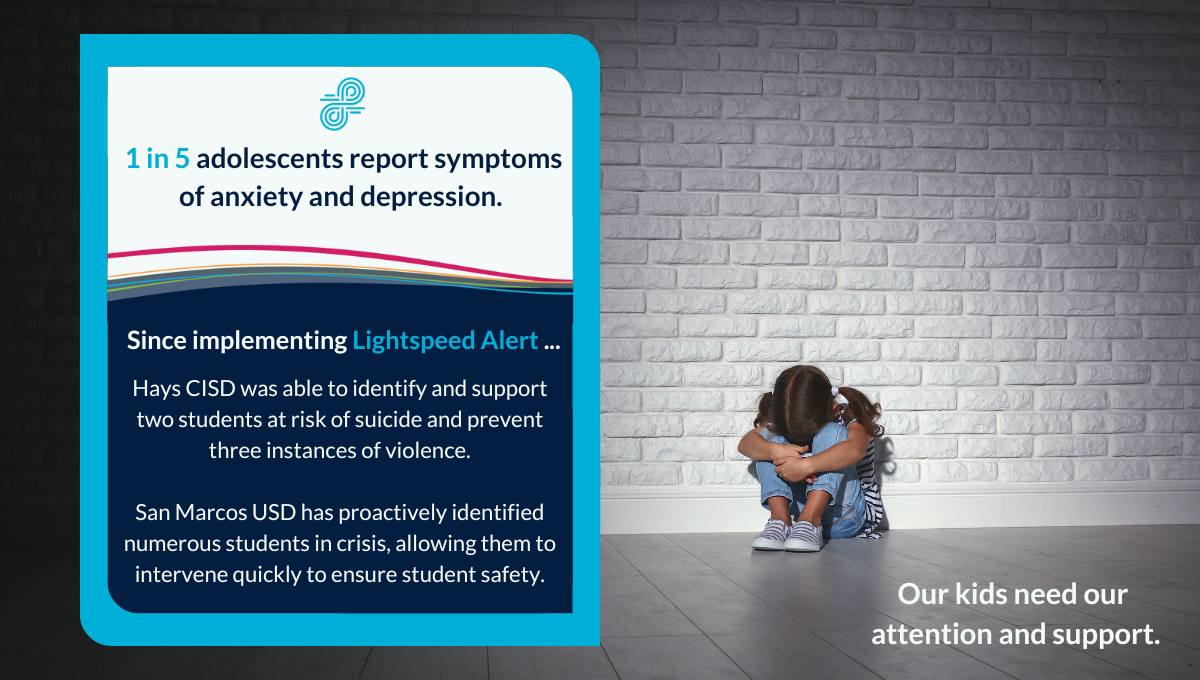May is Mental Health Awareness month. Throughout the month many important organizations have shared valuable resources and worked to raise awareness of the issue. But our work doesn’t stop when the calendar flips to June. As an education community, we must stay focused—our kids need our attention and support. Now is a critical time to ensure that your student safety and wellness strategy for the school year 2024-25 is adequate. Let’s take a closer look.
Recent statistics paint a bleak picture of the psychological landscape of our nation’s youth:
- 42% of adolescents report feelings of sadness and hopelessness.
- 1 in 5 adolescents reports symptoms of anxiety and depression.
- The number of emergency room visits for self-harm rose 188% among teenage girls and 48% among boys.
- 22% of high schoolers have seriously considered suicide in the last year, and 10% have attempted it.
Schools offer a unique opportunity to support our struggling youth. Supporting students and their mental health is not only necessary to create a positive school climate but also a prerequisite for learning. Poor mental health has a significant impact on academic achievement. It is very difficult for students suffering from anxiety, depression, or other mental health issues to focus on learning. In fact, poor mental health is also a top contributor to chronic absenteeism.
Luckily, schools are in a unique position to offer support to our struggling youth. Not only do school-aged children and adolescents spend the majority of their waking hours in school, but more than 70% of children who receive mental health support do so in a school-based setting. More and more schools are boosting their mental health offerings to meet the increasing needs of their students. However, to provide at-risk students with the right support at the right time, schools need to be able to identify those in need and intervene as early as possible.
It is not surprising that startling trends like those above are mobilizing our schools and districts to act. Many are funding technology to quickly and effectively find those students in time to make a difference.

Identifying students struggling in silence
Today’s learning ecosystem is both physical and digital. Students are providing clues about their mental well-being in both. In fact, four out of five individuals considering suicide give some sign of their intentions. While disruptive or concerning behavior in school hallways, classes, and bathrooms may be noticeable by teachers and school staff, the school campus isn’t the only place districts must look for warning signs.
Students’ online activity can often reveal things they may feel uncomfortable sharing in person or with parents, like feelings of self-harm, harm to others, or suicidal contemplation. Examples of online signs of distress have been found in a variety of digital platforms, including:
- References to sadness and lack of hope in online journals.
- Suicide notes drafted in Google Docs.
- Final goodbyes shared in online chats.
- Research on suicide methods via a Google search.
This type of information can be invaluable to identify students in distress and get to them in time to make a difference in their lives, the lives of their families, and the school community at large.
Districts, like San Marcos United School District (USD) and Hays Consolidated Independent School District (CISD), have turned to Lightspeed Systems. Since implementing Lightspeed Alert, San Marcos USD has proactively identified numerous students in crisis, allowing them to intervene quickly to ensure student safety.
“I can tell you beyond a shadow of a doubt that we have saved students,” stated Christi Frias, Student Services Director. “We have sent out law enforcement, based on calls from Lightspeed Safety Specialists, and they have placed students on 5150 holds—either because they were planning to take their lives or harm someone else. This has happened more times than I can count.”
Similarly, within weeks of implementing Lightspeed Alert, Hays CISD was able to identify and support two students at risk of suicide and prevent three instances of violence. During the first nine months, Lightspeed Alert identified 332 high risks and 16 imminent threats to student safety. “We were shocked by the number of real threats to our students we were alerted on,” states Kris Peterson, Director of Administrator Support.
This comprehensive coverage gives the district visibility into warning signs they would not normally see. “Externally, kids might not show signs that something’s going on, but they’re confiding in their devices these days, and we had no way to monitor that,” says John Gonzalez. “We’ve been able to identify students that really needed help but weren’t asking for it. Counselors were able to move them toward help, medication, treatment plans,” says John Gonzalez. School counselors have really embraced Lightspeed Alert and have come to rely on it daily. “They are able to help kids that were not on their radar. And, for kids that were on their radar, it has showed them that they may be worse off than they thought,” says Gonzalez.
San Marcos USD, Hays CISD, and school districts around the country are employing innovative technology to increase visibility into early warning signs and drive proactive support for at-risk students. Not only have these measures helped countless students, but they are also working to increase awareness around the need for more mental health resources. As Mental Health Awareness month winds down, let us take the time to think about our own struggling youth, recognize the current efforts schools are taking to address their mental health needs, and discuss how we can all be supporting them better.
Learn more about Lightspeed Systems, Lightspeed Alert, our team of Lightspeed Safety Specialists, and our newest partnership with the UGLI foundation to stop bullying before it impacts a student’s well-being.

